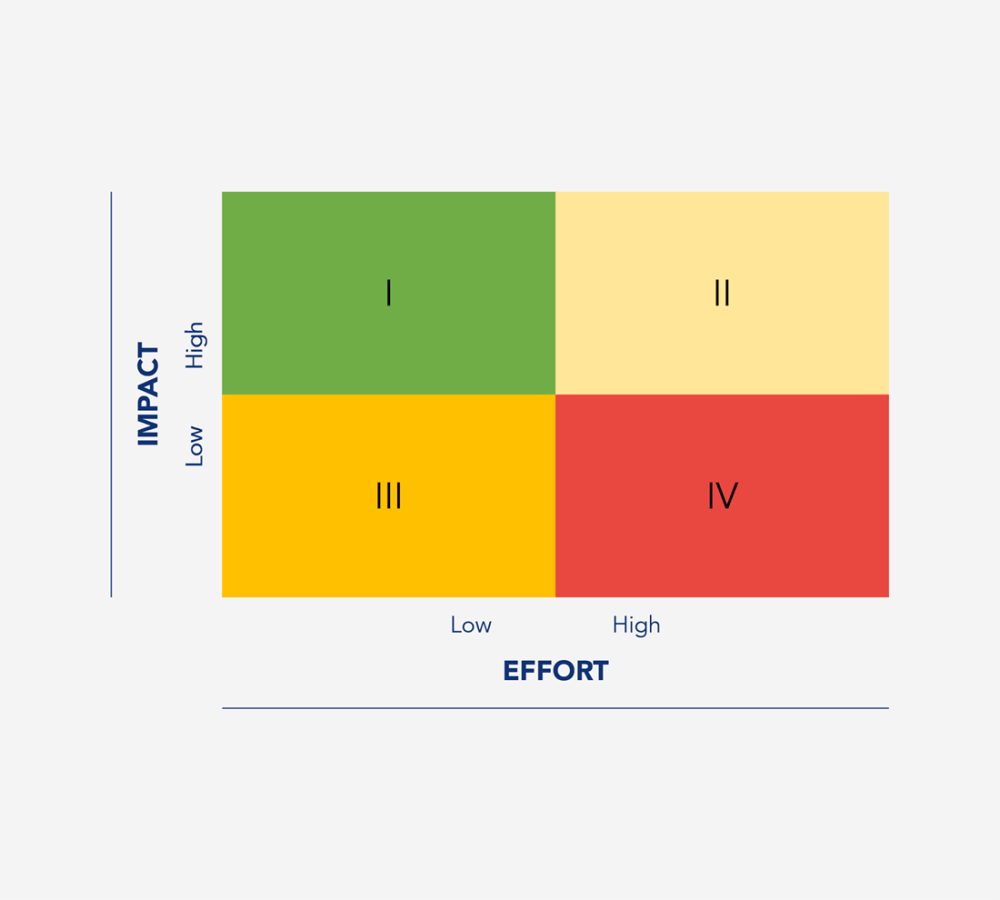Teams focused on selling
The rapid evolution of business processes and the constant market demands have disrupted companies, particularly marketing & sales teams. This acceleration triggered the need to develop more efficient sales teams capable of delivering results. So, if organizations want to have high-performing sales teams, it is essential that salespeople are available for the activities where they add value to the business: sales.
To do this, it is necessary to eliminate, diminish, or discard everything that is non-value-added. This process of eliminating waste must be implemented, following a holistic and systematic approach, while involving the teams that are being improved. According to recent research, salespeople spend more than 60% of their time on non-value-added activities. This results in teams with low productivity and results that fall short of their potential.
Waste concept
Waste or Muda (Japanese term used to define waste) refers to any activity that consumes resources without creating value for the customer. The elimination of waste, and the focus of the teams on value-added activities plays a key role in the day-to-day life of organizations and, above all, in the company’s results.
In the world of sales, you add value whenever you interact with a potential customer according to the defined standard. All the remaining activities can be classified as Muda.
The concern with the identification and elimination of waste, and its categorization into seven types was first raised by Taiichi Ohno while working at Toyota. Although this waste model emerged in the operational areas of the automotive industry, these seven categories can also be applied to sales activities as we can see in the following table.
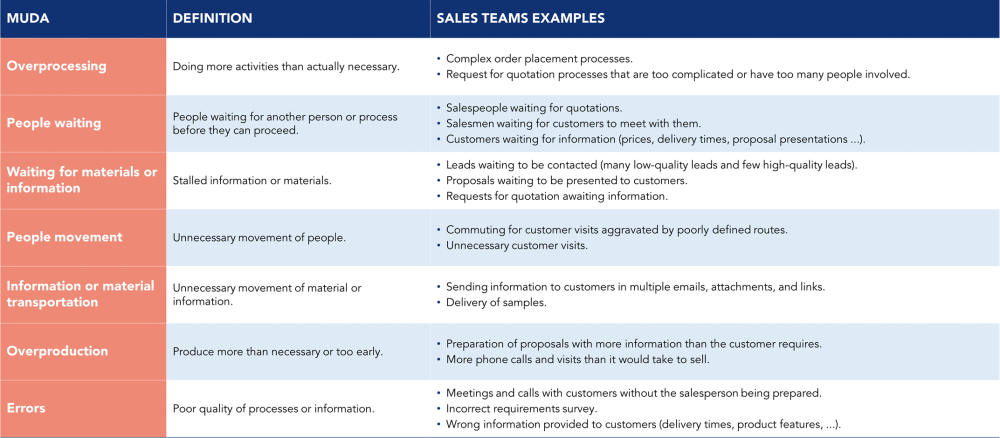
All the activities that salespeople perform to close deals are part of a process. The goal is to be able to eliminate all types of Muda and thus shorten the process, improve productivity, improve customer service, and increase revenues.
The different types of waste
Waste can be divided into two types. That which does not add value but cannot be eliminated in accordance with current paradigms, and that which we can eliminate immediately.
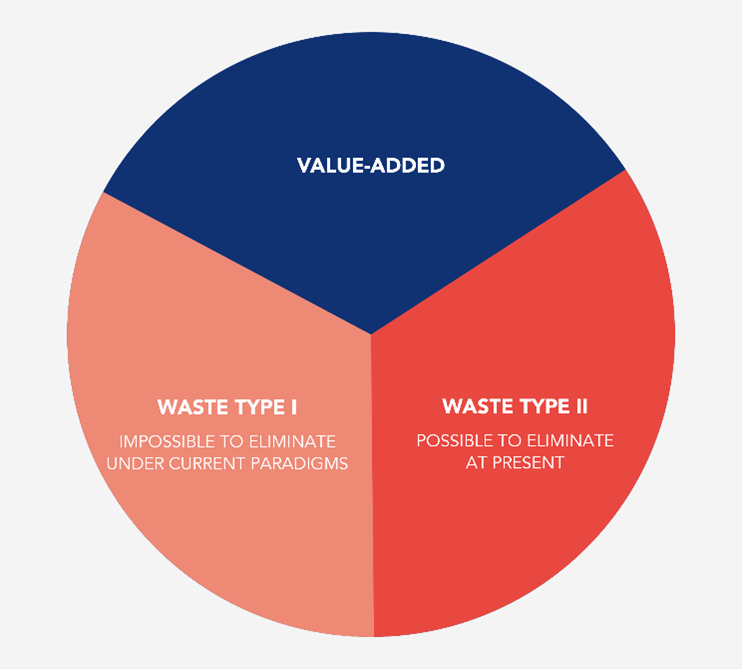
Waste that can be eliminated
These are activities that consume resources, add no value to the product or service, and can be quickly eliminated:
- Excessive visits or phone calls to customers
- Preparation of proposals with more information than the customer requires
- Errors in order placements which leads to complaints and reworks
- Outdated customer information
‘Necessary’ waste
These are activities that do not add value to the product or service but currently need to take place for a given reason, such as:
- Travel to meet with the customer
- Elaboration of proposals
- Sending samples
Even though it is not possible to eliminate these wastes immediately, it is usually possible to minimize them.
Waste elimination process
The process of eliminating waste must follow a logical sequence of steps. These steps are:
1. Definition of the notion of waste and added value
2. Data collection, compilation and analysis
3. Definition of solutions to fight waste
4. Action plan development and monitoring
All these steps are carried out with the teams targeted for improvement, and all decisions must be data-driven.
1. Definition of the notion of waste and added value
Before starting to collect data or thinking about improvements, teams ought to be clear on two concepts:
- Added value: activities for which the customer is willing to pay for
- Waste: activities that consume resources without creating value for the customer
These concepts must always be adapted to the team’s reality. As a sales team, it is necessary to discuss this concept in the context of selling while keeping the customer’s perspective in mind. Before moving on to the next step, everyone within the team must understand the definitions.
2. Data collection, compilation and analysis
Data collection is usually done by selecting a sample of salespeople who record all their activities during a week. The sample must be representative of the whole scenario. In smaller teams, everyone can be involved in this process.
Once the team that will do the log is selected, it is necessary to explain the document’s structure where the data will be recorded and validate whether all the activities performed by the team are identified in the file; if not, it will be necessary to add them.
The Week In the Life Of (WILO) log allows you to collect real data on all activities performed by the team, regardless of whether they are Muda or added value.
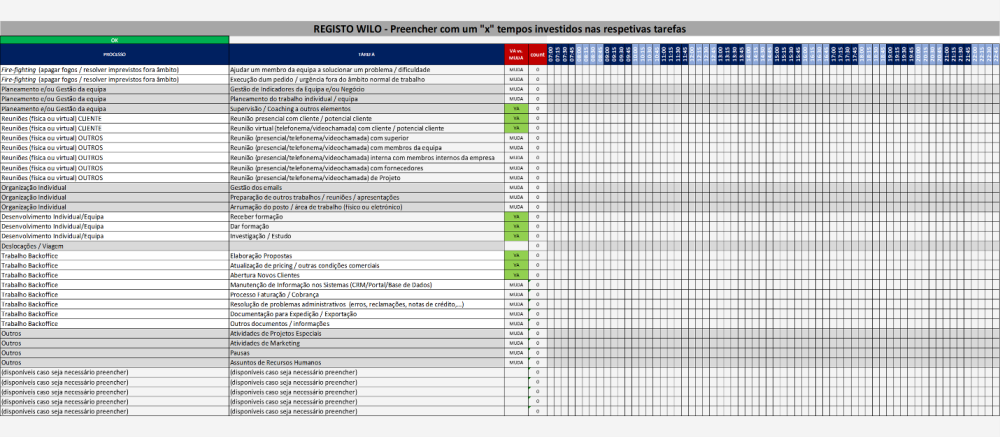
It is important for the team doing this to perform their regular routines so that the data is reliable. With 15-minute time blocks, the salesperson logs the activity performed.
At the end of the week, the individual logs are compiled.
Once all the data is collected, it is possible not only to compare the percentage of Muda with the percentage of added value, but also to understand which tasks the team is investing more time on. Usually, graphs are created that allow all the information to be visually analyzed.
At this stage, one begins to be aware of the true potential for improvement.
3. Definition of solutions to fight waste
Once the waste is identified, it is necessary to think of ways to eliminate it. One starts with the waste that consumes most of the team’s time. For every waste, you should think about whether it is possible:
1. To eliminate it – or
2. To minimize it; after minimizing it, then
3. Transferring it to support teams, if possible
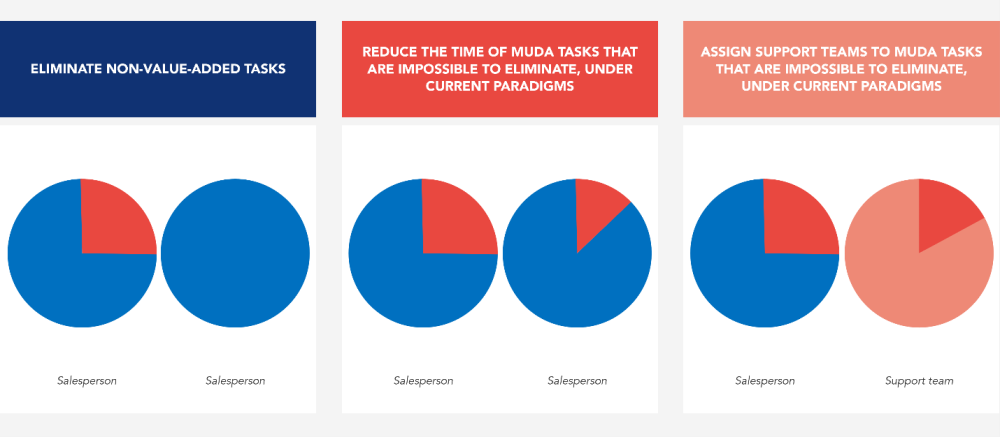
Eliminating waste is always the goal, but it is not always possible. In these cases, we should think about how we can minimize it. A typical case common in sales teams are customer visits – some can be eliminated, but many will have to be kept. In this case, it is necessary to ensure that there is good planning and that the routes are optimized.
Another solution when you can’t completely eliminate waste is to minimize it and then pass it on to the support teams. In other words, the focus is on maximizing the utilization of the sales team’s capacity and reducing and isolating variability and waste in support teams. Concentrating variability, non-value-added activities, and the organization of work in support teams, such as budgeting, complaints management, after-sales service, and others, will allow the sales team to focus on value-added activities: sales.
In this solution design phase, it is often necessary to collect additional data, analyze the current standards and processes, and also analyze the software used.
After the solutions have been identified, it is usually essential to define the implementation priorities. To help in the prioritization process, the Effort vs. Impact matrix is used. This matrix is divided into two axes. The first, which deals with impact, considers factors such as sales, increased productivity, and customer satisfaction. The second, effort, considers the time, energy, money, or resources required to implement the task. The matrix is therefore divided into four quadrants:
- Low effort and high impact (I): The actions in this quadrant are the priority ones because they bring great results with little effort
- High effort and high impact (II): The activities present in this quadrant are of second priority because, when carried out, they generate significant results, but require a high effort from the organization
- Low effort and low impact (III): The tasks in this quadrant require little effort and the results are of low impact, and it is advisable to check whether the action is really necessary
- High effort and low impact (IV): The actions that remain in this quadrant do not bring relevant results to the company and require a great deal of effort, so they often fail to be implemented, at least in the initial phase.
4. Action plan development
Once the solutions have been defined, it is essential to define the actions needed to put them into practice. For the implementation of each solution, more than one action may be required.
It is in the action plan that the work needed to implement the actions is organized and controlled. Each action will go through the following stages: PDCA (PLAN – planned; DO – implemented; CHECK – verified; ACT – deviations rectified).
All actions must have an assigned person responsible and a defined date for completion.
The team should meet with a standardized frequency to ensure that the actions are implemented and to measure their impact on reducing waste. It is important to ensure that decreasing waste does not negatively impact other indicators – such as customer satisfaction.
The impact of waste elimination on sales increase
This whole process allows teams to reduce waste, freeing up time for the sales process. These initiatives have an impact on team productivity, cost reduction, improved customer service, and also on the motivation of the teams, all of which are reflected in a clear revenue increase.
Eliminating waste is a key part of the sales improvement process, but not the only one. The other part is associated with the optimization of the sales process itself, in which concepts such as the purchase cycle funnel and value selling are addressed, which are also essential for business growth.
To conclude, the challenge for companies is to be able to implement a culture of continuous improvement that allows, on one hand, the elimination of waste, and on the other hand, an increase in value for the customer.
See more on Marketing & Sales
Find out more about improving this business area

